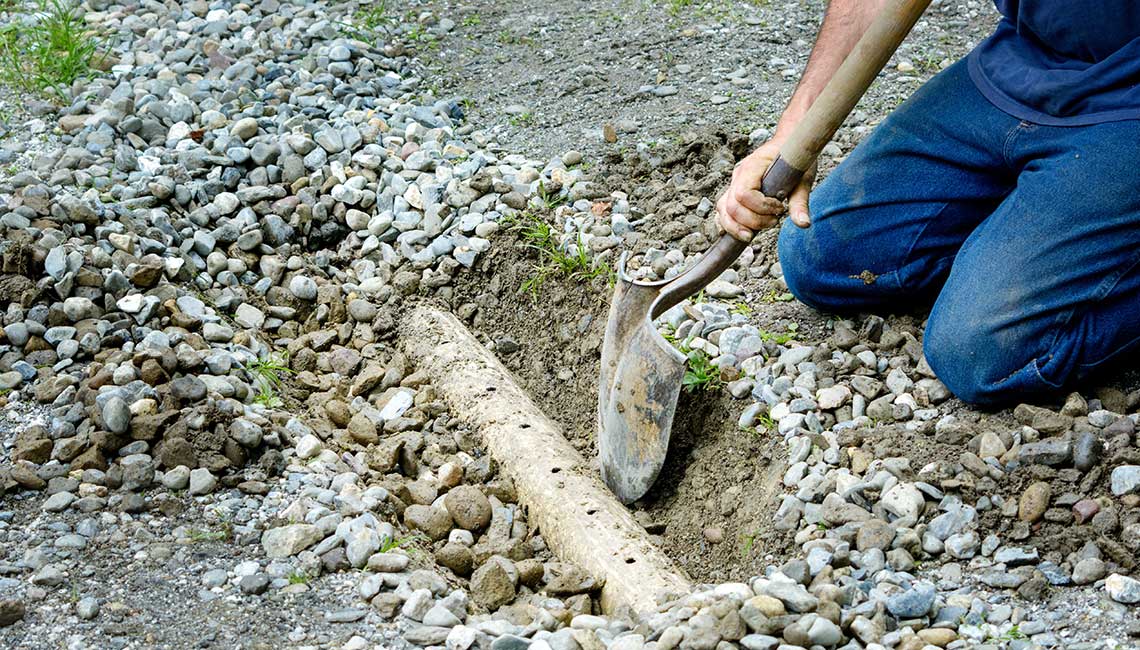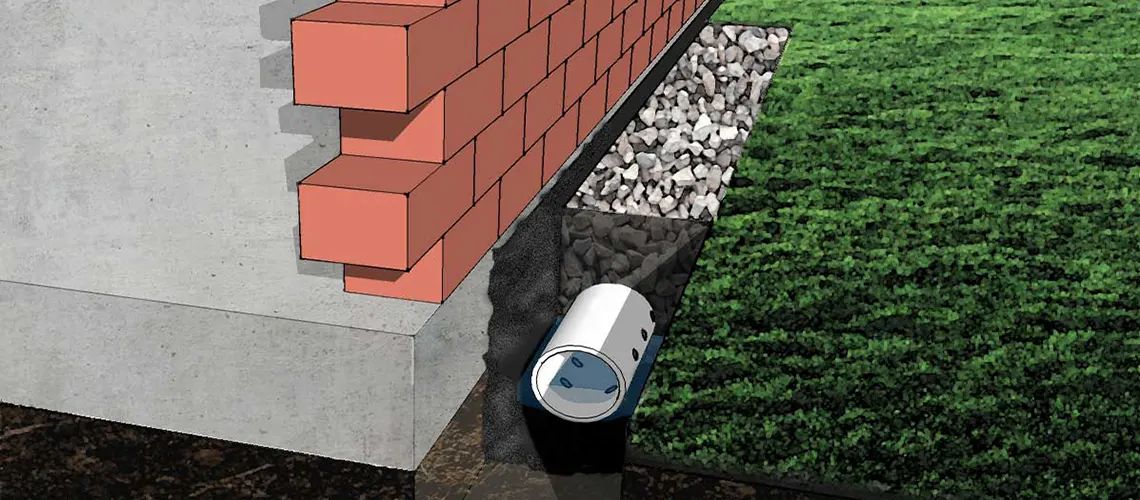How a Portland French Drain Stops Underground Flooding
How a Portland French Drain Stops Underground Flooding
Blog Article
The Crucial Overview to Maintaining Your French Drainpipe for Lasting Performance
Keeping your French drain is key to its effectiveness and your property's protection. Routine checks can conserve you from expensive repairs and water damage. You'll wish to know what signs to look for and just how often to check your system. And also, recognizing the cleaning procedure can make a significant difference. Allow's discover the necessary actions for ensuring your drain works well for several years ahead.
Comprehending the Function of a French Drain
A French drain is a critical part in taking care of water around your home. It directs excess water away from your structure, avoiding flooding and damages. When heavy rainfall drops, the drainpipe gathers water via a perforated pipeline buried in gravel. This system allows water to move easily, lowering pressure on your cellar walls and lessening the threat of leaks.You might question just how it operates in practice. As water fills the soil, gravity draws it towards the drainpipe. The perforated pipeline catches this water, transferring it to a designated drain area or tornado sewer. This process maintains your backyard dry and safeguards your home's architectural integrity.Understanding just how a French drainpipe functions is crucial to appreciating its value. By efficiently carrying water away, it helps maintain a dry and secure living atmosphere. Maintaining your French drain in leading problem assurances you stay clear of pricey repair services down the line.
Routine Inspections: What to Search for
When you're inspecting your French drain, start by looking for any obstructions that could be obstructing water circulation. Take note of signs of surface area disintegration around the drain, as this can suggest possible issues. Routine analyses will assist maintain your water drainage system functioning effectively.
Clogged Drainpipe Evaluation
How can you tell if your French drainpipe is blocked? Watch for water pooling in your yard, especially after hefty rain. That's a red flag if you discover areas where water gathers rather of draining. You should additionally check the drain outlet; if water isn't spurting as it should, there's most likely a clog. Pay attention for unusual gurgling sounds, which can suggest trapped air. Additionally, examine the drainpipe's surface for any kind of plant life development, as origins can infiltrate and obstruct the system. Finally, if you smell stuffy smells, it could aim to stagnant water brought on by an obstruction. Frequently assessing these indicators can aid you maintain your French drain efficiently and stop expensive repair services.
Surface Disintegration Examine

Cleaning Your French Drain: Step-by-Step Guide
Cleaning your French drain is essential for maintaining it operating effectively. You'll require some details tools and a clear procedure to ensure everything runs efficiently. Allow's walk via the actions and tips for maintaining your drain effectively.
Tools You'll Require
To tackle the task of cleaning your French drain properly, you'll intend to gather a few crucial devices. Grab a sturdy pair of handwear covers to secure your hands from particles and sharp items. A small shovel or trowel will certainly aid you get rid of dust or clogs around the drain. For removing out the inside, a plumber's snake or a high-pressure water nozzle can be extremely helpful. You'll likewise require a pail for accumulating any kind of particles you pull out. Having a yard hose on hand will make it much easier to rinse out the drainpipe and ensure it's flowing smoothly. With these tools ready, you'll be set for a thorough cleansing session!
Cleaning Process Actions
Begin by examining the area around your French drainpipe for any noticeable debris or obstructions. Remove leaves, branches, or dust that may block water flow. Next, inspect the inlet and outlet areas; clear any kind of obstructions to guarantee proper drainage. Use a yard pipe to flush the drain, guiding water into the inlet. This assists dislodge any type of accumulated sludge or sediment. If you discover persistent blockages, take into consideration making use of a plumbing professional's serpent to break them up. After cleansing, inspect the gravel around the drainpipe; restore it if it's gotten rid of. Validate the drain covers are undamaged and safely in place to stop particles from getting in. Regular cleansing keeps your French drain working effectively.
Upkeep Regularity Tips
While routine maintenance is crucial for your French drain's long life, knowing how usually to preserve it can make all the difference. Preferably, you need to check your French drain at the very least two times a year, ideally in spring and fall. After hefty rainfall or snowmelt, look for obstructions or particles. If you see any standing water, it's time to cleanse your drain.In areas with heavy vegetation, more frequent upkeep-- about every three months-- may be necessary. Additionally, take into consideration cleansing your French drainpipe after major storms or if you observe water merging in your yard. By staying positive, you'll guarantee your French drainpipe features successfully and safeguards your residential or commercial property from water damage. Regular checks will certainly conserve you money and time over time.
Determining Typical Problems and Their Solutions
It's crucial to recognize common issues with your French drain and apply efficient options when you observe water merging in your lawn or damp spots in your basement. One frequent issue is blocking, usually triggered by debris like leaves or debris. To repair this, you can utilize a plumbing snake or a high-pressure water jet to clear blockages.Another issue could be improper incline. Water won't move away from your home if your drainpipe isn't sloped properly. You can adjust the incline by digging and rearranging the drainpipe pipe.Lastly, look for damages or splits in the drainpipe itself. Changing the damaged sections is essential for peak efficiency if you discover any kind of. By dealing with these issues promptly, you'll assist guarantee that your French drain continues to operate efficiently, securing your building from water damage and keeping a completely dry, safe setting.
Seasonal Upkeep Tips for Your French Drainpipe
Resolving typical issues with your French drain is simply the initial step in assuring its long-term performance. Seasonal upkeep is crucial for peak performance. In the springtime, eliminate leaves and debris that may have gathered throughout wintertime. Inspect for any type of clogs in the electrical outlet or capture basin, as water requires a clear course to stream freely.During summer, inspect your drain for any kind of indications of clearing up or moving dirt. you can try these out Make certain it's still degree and working appropriately. As fall methods, clear out any type of fallen entrusts to prevent blockages before winter arrives.In wintertime, expect freezing temperature levels. Make certain your drain isn't at risk of cold if you live in a cool environment. Shielding exposed pipelines can assist. Routine checks and timely maintenance can prevent pricey repairs and maintain your French drainpipe functioning efficiently year-round. Keep proactive and appreciate assurance knowing your drainage system is in good condition!
When to Employ a Specialist
Understanding when to call a professional can conserve you time and stop more damages to your French drainpipe. If you see consistent standing water in your backyard, it's a clear indication that your drainpipe might be clogged or damaged. Don't overlook strange smells, as they can indicate sewage backup or decay, which requires immediate attention.If you find that your drain isn't functioning correctly after attempts to clean or keep it, it's time top article to connect for expert help. Additionally, if you're not sure concerning the underlying concerns or do not have the essential tools, hiring an expert can give tranquility of mind.Finally, if your French drainpipe is old or has experienced considerable damage, professional evaluation can figure out whether fixings or full substitute is required. Count on the professionals to assure your drainage system functions successfully for several years to come.
Tips for Stopping Future Water Drainage Troubles
To maintain your French drain operating successfully, regularly inspecting and keeping it can make all the distinction. Beginning by removing debris, leaves, and dirt from the surface area and drain openings. This prevents blockages that can cause water backup. Examine the gravel around the drain; if it's compacted or eroded, think about including fresh crushed rock to keep optimal flow.Next, divert water far from your drainpipe by ensuring downspouts and rain gutters are clear and guiding water a minimum of three feet far from your structure. Routinely check for any type of visit homepage indications of damage or drooping. If you notice concerns, resolve them immediately.Finally, think about mounting a filter or a catch container to catch bigger particles prior to it enters the drain. By remaining aggressive with these ideas, you'll reduce the risk of future drain troubles and keep your French drainpipe in leading form.
Regularly Asked Questions
For how long Does a French Drainpipe Usually Last?
A French drainpipe normally lasts around 30 to 40 years, relying on the products made use of and maintenance (Portland French Drain). If you stay on top of routine checks, you can extend its lifespan also further
Can I Install a French Drainpipe Myself?
Yes, you can install a French drain on your own if you have actually got the right devices and expertise. Just ensure to plan meticulously, adhere to local regulations, and guarantee proper drain to avoid future concerns.
What Products Are Made Use Of in a French Drain?
You'll require perforated pipeline, gravel, landscape fabric, and a strong water drainage pipeline for your French drainpipe. These products assist reroute water effectively, avoiding flooding and maintaining your home safe and completely dry from water damages.

Is a Permit Required to Set Up a French Drainpipe?
You'll likely need a permit to mount a French drain, depending upon regional laws. Consult your community to assure you abide by any essential guidelines and stay clear of potential issues during installation.
What Are the Prices Connected With French Drain Maintenance?
Maintaining a French drainpipe typically sets you back between $100 and $500 every year. You'll need to think about costs for cleansing, repair work, and assessments. Routine upkeep helps prevent larger assurances and costs your system operates correctly for many years - Portland French Drain. When you're inspecting your French drain, begin by examining for any kind of obstructions that might be obstructing water flow. By remaining aggressive, you'll ensure your French drain functions efficiently and secures your property from water damage. When you discover water pooling in your yard or damp places in your cellar, it's vital to determine usual problems with your French drain and carry out reliable solutions. You can adjust the incline by digging and rearranging the drainpipe pipe.Lastly, check for damages or cracks in the drain itself. Examine the crushed rock around the drainpipe; if it's compacted or deteriorated, consider including fresh crushed rock to keep suitable flow.Next, draw away water away from your drainpipe by making sure seamless gutters and downspouts are clear and guiding water at least 3 feet away from your structure
Report this page